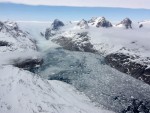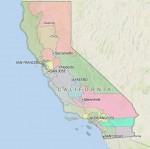Featured
Monday, January 8th, 2018
NASA, the National Oceanic and Atmospheric Administration (NOAA), and the U.S. Geological Survey (USGS) should join forces to track changes in Earth’s temperature, according to a federally funded study on climate change. The three agencies should implement “a coordinated approach for their space-based environmental observations to further advance Earth science and applications for the next

Monday, January 1st, 2018
NASA scientists conducting research on the connection between fuel moisture and fires uncovered a paradox: a wet winter corresponds to more small wildfires in the following fire season, not fewer, as is commonly assumed. Large fires behave more “logically,” with fewer large fires after a wet winter and more after a dry one. “This is

Monday, December 18th, 2017
Along with the larger forces of climate change, another contributing factor to the fierce wildfires in California has been the dry soil conditions. Light rainfall, combined with heavy use of aquifers by large farms, has created perfect conditions for an inferno. Stories of homeowners saving their homes by turning on sprinklers remotely are not as

Tuesday, December 12th, 2017
Esri and the United Nations Statistics Division (UNSD) are working with a number of member states to utilize a data hub that will allow countries to measure, monitor and report on the Sustainable Development Goals (SDGs) in a geographic context. This new hub, called the Federated System for the SDGs, is based on Esri’s ArcGIS

Tuesday, December 5th, 2017
Esri will donate personal-use licenses of its ArcGIS software for each GISCorps volunteer who takes a GIS Service Pledge to volunteer for a good cause. GISCorps is a program of the Urban and Regional Information Systems Association (URISA) and has been providing a range of mapping and disaster response services for more than 14 years

Monday, November 27th, 2017
Monitoring ocean salinity is essential for understanding its impact on ocean circulation, Earth’s water cycle, marine ecology and climate change. Ocean salinity in the Arctic is of particular interest, because it changes significantly with seasonal ice cover and is expected to decrease as the Greenland ice sheet melts and releases massive amounts of freshwater. Despite

Monday, November 20th, 2017
Legislative sponsors Senator Orrin Hatch (R-UT) and Senator Mark Warner (D-VA), U.S. Representative Bruce Westerman (R-AR-04), and U.S. Representative Seth Moulton (D-MA-06) collaborated with GIS organizations across government and industry to advocate for common data standards, interagency collaboration and transparency to taxpayers on shared national data services. Agreeing to a common vision will make it

Monday, November 13th, 2017
Boeing completed the acquisition of Aurora Flight Sciences Corp., which will operate under Boeing Engineering, Test & Technology as a subsidiary called Aurora Flight Sciences, A Boeing Company. It will retain an independent operating model. Headquartered in Manassas, Va., Aurora has more than 550 employees and operates in six locations, including research and development centers

Monday, November 6th, 2017
Members of the California Citizen’s Redistricting Commission went to Washington, D.C. in July 2017 to accept the Roy and Lila Ash Innovations Award for Public Engagement in Government for its California Redistricting Panel, which used Caliper’s Maptitude for Redistricting to draw its 2012 Congressional and State Legislative boundaries that have been recognized for effectively eliminating

Tuesday, October 31st, 2017
The European Space Agency (ESA) and Radiant.Earth will jointly enhance geospatial data literacy in the global development community to help track the Sustainable Development Goals (SDGs). “Geospatial information is central to accurately tracking and measuring the global progress of the SDGs,” noted Radiant.Earth Founder and CEO Anne Hale Miglarese. The ESA and Radiant.Earth cooperation focuses


